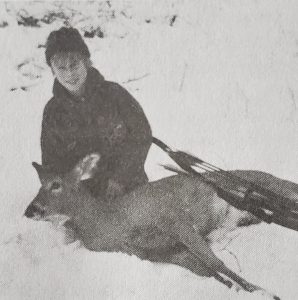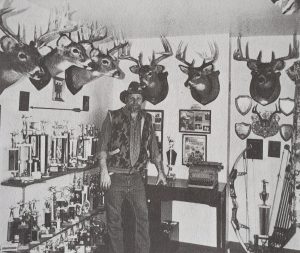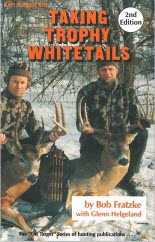To gain the necessary knowledge, you have to take animals.
by Bob Fratzke
First, you have to analyze what, exactly, you want to do or how good you want to be at it or how much time you can spend at it. I used to go all out. I considered myself a good waterfowl hunter, a good grouse hunter, a good pheasant hunter, and all that. But when I got into bowhunting I figured if I wanted to do it well, the best way would be to cut way back on the other things or quit them. I guess I really wanted to hunt good whitetails.
Good bow hunting takes time. I don’t believe you can start out as a trophy hunter, because there is a lot of bowhunting knowledge you can pick up only in the woods…on the firing line, so to speak. You can read books. You can read magazines. You can go to seminars, and you can talk to other bowhunters. But the best that you can do is get well prepared, have a fairly good idea of what to do, what to look for, and what to expect.
Most things you pick up will be useful to you in your hunting area, but not everything translates. There are regional and local differences. (However, you also can carry this idea of “differences” too far. I don’t know how many times I’ve talked to guys about certain things basic to whitetails and whitetail hunting, and one of the first questions is “Yah, but will that work in my area?”)

Any whitetail is a trophy, especially the first couple you tag when you’re still learning what it’s all about, no matter whether buck or doe.
To gain the necessary knowledge, you have to take animals. You learn, at the very least, when to draw on an animal and when not. You learn what they do under certain conditions of weather and alarm or suspicion. You learn how they live.
You can’t learn if you’re saving all your luck for that one shot at a trophy animal. Waiting for that monster to be the first one you tag, or nearly the first one, and I guarantee at least nine times out of ten you’ll blow it.
Getting your feet wet without worrying about a trophy helps you learn tracking and trailing. Any time you get a chance, you ought to help track. You learn a lot, and it’s fun. Sort of like unraveling a mystery.
Get involved with other hunters this way…to learn something. If somebody hits an animal and needs help, go help. Don’t get in the way, though. Be a help, not a bother.
Now and then you’ll run into bowhunters who don’t shoot because they’re afraid to miss, afraid they’ll lose an expensive arrow, afraid of who knows what. That really translates into a lack of confidence, which brings me back to the same thing…nothing beats the experience of getting a couple of animals tagged. You can’t kill an animal with a quiver full of arrows.
That experience will tell you how far to let an animal come in, what’s too close and what’s not close enough, what’s a high percentage shot, and what’s a low percentage shot.
You’ll learn, for instance, that when the animal is in good range –20 yards or thereabouts —take the first decent shot. Don’t wait for a better one. That very seldom happens. A lot of hunters just starting to want to wait for that better shot, and they can all tell stories about the deer that didn’t really seem spooked but somehow managed to keep brush or saplings or something between them and the hunter, and they’re just never was a shot opportunity. And all of a sudden the deer was gone.
You need to know whether your camo clothing is right, whether your equipment is silent, how and when to move…the countless details that must fall into place if you’re to tag a whitetail. Because if something can go wrong, it will. You want to iron out those problems on animals that won’t have so much tension surrounding their taking.
Just remember, nobody begins playing baseball in the major leagues…and not many people get up there, either.
Successful trophy whitetail hunting takes work and more work and clear thinking and time in the woods. You must pay your dues.

Fratzke is adept in the woods. To be consistently successful, a bowhunter needs to be able to find unalarmed deer and then hit them right when he finds them.
TAKING TROPHY WHITETAILS, by Bob Fratzke, was one of the first books we published. Its how-to whitetail deer hunting information is still rock solid, although some of the equipment shown won’t look new. Bob Fratzke, a Minnesota bowhunter and 2016 member of the Minnesota Archery Hall of Fame, is one of the best whitetail hunters we have ever known.
Bob is probably the leading proponent — and practitioner — of thorough scouting. Ninety percent of his total hunting and hunting-related effort involves scouting. Why? To get to know the terrain, the cover, the food sources, and the animal movement patterns as intimately as possible. This preparation raises his confidence level, prepares him for the hunt, allows him constantly to hunt fresh stands, and avoid over-using any given stand.
When you do your scouting homework, the hunting takes care of itself as long as you learn to read the woods, seeing what you’re looking at instead of just what you want to see, and then putting those signals to work for your hunting success.
 Consistently successful whitetail hunting — especially trophy hunting — means paying attention to details, from scouting through actual hunting, stand positioning, camouflage and equipment setup. In this book, Bob Fratzke gives you valuable information on these details.
Consistently successful whitetail hunting — especially trophy hunting — means paying attention to details, from scouting through actual hunting, stand positioning, camouflage and equipment setup. In this book, Bob Fratzke gives you valuable information on these details.
This Second Edition of TAKING TROPHY WHITETAILS includes detailed information on the startling things about whitetail behavior Bob has discovered through his intensive and extensive use of mock scrapes over the past several hunting seasons. He has deer scraping nearly year-round, creating new movement patterns which are where he wants them to be.
The book is available from www.targetcommbooks.com. All major credit cards are accepted. It is 5.5″ x 8.5″, 140 pages, paperback.

